Sarah L. Johnson's Blog, page 93
February 16, 2015
Review of Fiercombe Manor by Kate Riordan, a dual-period gothic saga
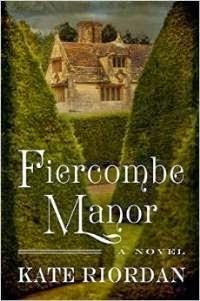 An isolated house allegedly filled with ghostly presences. Two women mired in restrictive social circumstances and linked over a generation. Secrets from the past reawakened years later. Atmospheric and resonant with emotion, Kate Riordan’s saga has many elements of the traditional gothic novel but is in other ways a refreshing departure.
An isolated house allegedly filled with ghostly presences. Two women mired in restrictive social circumstances and linked over a generation. Secrets from the past reawakened years later. Atmospheric and resonant with emotion, Kate Riordan’s saga has many elements of the traditional gothic novel but is in other ways a refreshing departure. Fiercombe Manor in Gloucestershire, a Tudor-era dwelling crafted of golden stone, sits at the base of a valley “so steep that it’s like an amphitheatre.” As Alice Eveleigh wanders the grounds and gets to know her temporary home during the languid summer of 1933, her observations form an inviting travelogue of this hidden corner of the Cotswolds.
Left pregnant after a brief affair with a married man, Alice is forced by her parents to leave London to stay with her mother’s old friend, Edith Jelphs, the housekeeper at Fiercombe, until the baby is born – after which it will be taken away and brought to an orphanage. Away from her mother’s disapproval, Alice thrives in her new environment, though her pretense of being a widow proves to be tiring. Mrs. Jelphs is kindly but cautiously watchful, more so as Alice begins quietly uncovering a local mystery.
A previous mistress of the estate, Lady Elizabeth Stanton was a dark-haired beauty who lived in nearby Stanton House in the late 19th century and who was pressured to produce a son. Why was Stanton House dismantled, and what became of Elizabeth and her daughter Isabel?
Hints of tragedy, inherited madness, and restrictions placed upon women wind through this dual-period novel, but while it offers occasional frissons of suspense, it lacks the terrifying menace typically found in the genre. The pacing is leisurely, and despite a past that holds overwhelming sadness, Fiercombe is a lovely setting in which to linger. If you google “Owlpen Manor,” the place that inspired it, you can visualize its charm.
Fiercombe Manor will be published by Harper tomorrow in hardcover ($26.99, 416pp). The UK title is The Girl in the Photograph. Thanks to the publisher for enabling access via Edelweiss. This review first appeared in February's Historical Novels Review .
This is Kate Riordan's second novel; the first, Birdcage Walk, is a murder mystery based on a real-life Edwardian crime. It's available in the US on Kindle for a mere $2.99, so I snapped it up.
And here's a pic of Owlpen Manor, to save you the extra step of googling. I would love to visit this beautiful place in person. Its website is here, and the owners even offer holiday cottages (very tempting!).
 Owlpen Manor at front right, Holy Cross Church in background.
Owlpen Manor at front right, Holy Cross Church in background. © Copyright Derek Harper, licensed for reuse under this Creative Commons Licence
Published on February 16, 2015 07:00
February 14, 2015
Book review: The Secrets of Sir Richard Kenworthy, by Julia Quinn
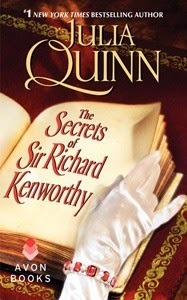 Sir Richard Kenworthy has some big secrets – does he ever. For his own private reasons, he travels south from Yorkshire to London to convince some eligible young lady to wed him at short notice. Quinn’s impressive romance, set in the post-Regency era, details the unusual courtship of Richard and Miss Iris Smythe-Smith both before and after his motives are revealed.
Sir Richard Kenworthy has some big secrets – does he ever. For his own private reasons, he travels south from Yorkshire to London to convince some eligible young lady to wed him at short notice. Quinn’s impressive romance, set in the post-Regency era, details the unusual courtship of Richard and Miss Iris Smythe-Smith both before and after his motives are revealed.The fourth of five daughters, Iris is a sensible woman who doesn’t attract attention, so she’s puzzled but quietly pleased when Richard asks to call on her. He’s handsome and kind, but what’s the hurry to get married? When he deliberately steals a kiss from her in sight of her aunt, he forces her hand – and when Iris learns his true purpose, her anger is justified.
While the premise feels a bit over-the-top, this novel is rooted in the conventions of its time, when one careless decision could mean social ruin. Both gentle yet witty, Richard and Iris are a well-matched pair. Quinn also accomplishes the near-impossible by redeeming Richard’s character in the eyes of Iris and the reader and by crafting a believable reconciliation.
There are some lovely descriptions of the Yorkshire countryside, and fans of the series (this is book #4) can look forward to more terrible music from the Smythe-Smith string quartet.
Here's a special feature for Valentine's Day: my first review of a historical romance here. If you've read this novel, what did you think? According to other reviews I've read, Richard is one of Quinn's more controversial heroes; you'll have to read the novel to see exactly why.
I wrote this review for February's Historical Novels Review; thanks to the publisher for granting me access via Edelweiss. The Secrets of Sir Richard Kenworthy was published by Avon in 2015 (384pp, $7.99 / $9.99 Can). The UK publisher is Piatkus (£8.99). It was named to the LibraryReads list for February.
Published on February 14, 2015 06:00
February 9, 2015
Charles Todd's A Fine Summer's Day, an Ian Rutledge prequel set in pre-WWI England
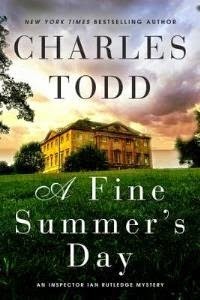 This 17th novel in the Ian Rutledge mystery series follows the successful pattern used in many of the previous books. An inspector at Scotland Yard, Rutledge puts considerable mileage on his motorcar, driving all over England interviewing villagers while cunningly assembling clues to track down a killer. His presence is alternately welcomed and resented by the local police, and his wits prove to be as sharp as ever. The difference? This entry turns back the clock six years, just prior to the wartime service that will leave him a haunted, shell-shocked veteran.
This 17th novel in the Ian Rutledge mystery series follows the successful pattern used in many of the previous books. An inspector at Scotland Yard, Rutledge puts considerable mileage on his motorcar, driving all over England interviewing villagers while cunningly assembling clues to track down a killer. His presence is alternately welcomed and resented by the local police, and his wits prove to be as sharp as ever. The difference? This entry turns back the clock six years, just prior to the wartime service that will leave him a haunted, shell-shocked veteran. In this prequel set in June 1914, Rutledge is just 23, a young policeman with a bright future in the Yard – if he can endure the Chief Superintendent’s antipathy. He’s naïve when it comes to women, though. Newly engaged, he thinks his pretty fiancée Jean Gordon will make him happy, while his sister and friends are doubtful. When he gets called to investigate a hanging in Yorkshire, he finds himself befuddled. The dead man was a successful furniture maker with no known enemies. Before long, Rutledge is assigned to investigate two other murders in different corners of the country, and the victims have similarly unblemished reputations.
Readers are shown the perpetrator at the beginning, but even after Rutledge figures things out, there’s still plenty of mystery left. The story becomes an exciting cat-and-mouse thriller as he pursues his man while determining the “how” and the “why.” Tension and atmosphere are added via Britain’s increasing slide towards war, Jean’s pressure on him to enlist, and his need to clear an innocent man before it’s too late. Despite one outlandish coincidence, this is a suspenseful mystery that grips one’s attention until the end.
A Fine Summer's Day was published in January by William Morrow in hardcover ($25.99 or Can$33.50, 352pp). This review first appeared in February's Historical Novels Review.
Some other notes:
- If you haven't already noticed, the "elegant country house" cover is on its way to becoming as prevalent as the "headless woman" cover. This doesn't indicate, in either case, that the books are all the same or even close to similar style-wise, though.
- Yes, this is 17th in a series, but because it's a prequel, you can read it first without any trouble. (I'm not one who needs to read series books in order, but I know others prefer to do that.) I've read many books in the Ian Rutledge series so far, including #1, 15, and 16, but not all of them yet.
Published on February 09, 2015 09:00
February 7, 2015
Lawrence Hill's bestselling The Book of Negroes, coming to American TV in mid-February
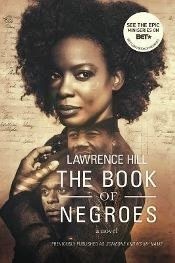 Hill’s third novel, a Canadian bestseller, is a masterful example of historical storytelling, one both heartbreaking and hopeful.
Hill’s third novel, a Canadian bestseller, is a masterful example of historical storytelling, one both heartbreaking and hopeful.When slavers wrest 11-year-old Aminata Diallo from her West African village in 1745, she vows to remember everything. After enduring the harrowing Middle Passage, she becomes the property of a South Carolina indigo farmer whose overseer notes her intelligence and secretly teaches her to read.
Whether keeping books for a Jewish businessman in Revolutionary-era Manhattan, documenting her fellow Black Loyalists before their transport to Nova Scotia (reflecting Hill’s original title, The Book of Negroes), or joining the British colony of Freetown, Sierra Leone, Aminata retains her self-respect. Throughout her life, she holds tightly to the idea of freedom for everyone forced into slavery, and to her love for the African husband from whom she’s constantly separated.
By the time Aminata journeys to London in 1802 as a symbol of the abolitionist movement, readers will have witnessed the dehumanizing slave trade from inside and out. An unforgettable epic, seen through the eyes of a sharply realized, indomitable heroine.
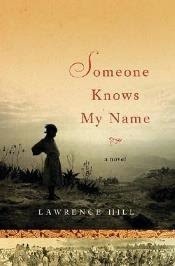 The review above first appeared in Booklist's 10/15/2007 issue. The book's U.S. edition was published by Norton under the title Someone Knows My Name. (For background on how that came about, read the author's piece in the Guardian, "Why I'm Not Allowed My Book Title.") And for the record, the "Book of Negroes" is an important historical document, one that lists the over 3000 black refugees who arrived in Nova Scotia following the American Revolution.
The review above first appeared in Booklist's 10/15/2007 issue. The book's U.S. edition was published by Norton under the title Someone Knows My Name. (For background on how that came about, read the author's piece in the Guardian, "Why I'm Not Allowed My Book Title.") And for the record, the "Book of Negroes" is an important historical document, one that lists the over 3000 black refugees who arrived in Nova Scotia following the American Revolution. I had mentioned the original title in the review to honor the writer's choice and to alert readers that Someone Knows My Name and The Book of Negroes were the same book.
The Book of Negroes, which won the Rogers Writers' Trust Fiction Prize and the Commonwealth Writers' Prize, was selected for Canada Reads in 2013 and has become a modern classic.
Norton has re-released the novel in trade paperback (image at top left) to coincide with the American premiere of the six-part TV miniseries based on the book, which stars Cuba Gooding Jr., Jane Alexander, Louis Gossett, Jr., and Aunjanue Ellis as Aminata. It will be shown on BET on February 16, 17, and 18; check your local listings for times. My DVR is set to record it. For the Canadian readers who have been watching it on CBC, what did you think?
Published on February 07, 2015 06:39
February 4, 2015
Mystery meets the Manhattan Project: Diane Fanning's Scandal in the Secret City
 The high-security, covert area known as Oak Ridge, Tennessee – over 50,000 acres of land set aside by the U.S. government for the development of a nuclear bomb – has great potential as the setting for a historical mystery. Fanning’s intricate and smart new novel makes excellent use of the material.
The high-security, covert area known as Oak Ridge, Tennessee – over 50,000 acres of land set aside by the U.S. government for the development of a nuclear bomb – has great potential as the setting for a historical mystery. Fanning’s intricate and smart new novel makes excellent use of the material. Libby Clark, a recent UPenn grad with a master’s in analytical chemistry, is thrilled to get a job offer from Eastman Kodak since there aren’t many employers in 1942 who’d hire a female scientist. The utter secrecy under which she’s ordered to carry out her tasks turns sinister, though, when her former roommate’s sister is murdered.
Irene Nance was an easygoing young woman with an active love life. When Irene’s body is mysteriously moved (something the authorities deny doing), Libby suspects a cover-up but doesn’t know the reasons why. Having promised Irene’s family to seek justice for her, Libby gets stonewalled at every turn and takes a huge risk by pursuing an investigation. That’s on top of dealing with sexist remarks from coworkers with less technical knowledge than she has.
The timeline feels a little awkward in the beginning with its multiple-flashback structure, but this is a minor issue. The geographical layout and high-pressure atmosphere of Oak Ridge are re-created in extensive detail, as is the curious plight of its scientists, who are simultaneously proud of their work for the war effort and concerned about what they believe is their project’s end result.
Libby herself is a brave and admirable career woman, and seeing her in action, carefully hunting the truth while refusing to play down her expertise, makes for a very satisfying story. There are enough clues for readers to guess the killer well before Libby does, but even so, her appearance in future volumes in the series is eagerly awaited.
Scandal in the Secret City was published by Severn House in 2014 in hardcover ($28.95 or £19.99, 256pp). Thanks to the publisher for approving my NetGalley access. This review first appeared in February's Historical Novels Review.
Published on February 04, 2015 17:59
February 1, 2015
Congratulations to the historical fiction winners of the 2015 ALA RUSA awards
I was in the audience when the winners of this year's book and media awards from the American Library Association's RUSA (Reference & User Services Association) were announced earlier tonight in Chicago. Congratulations to all of the winning and short-listed authors!
Because of this blog's focus, I'll specifically list just the winners that fit with the genre of historical fiction.
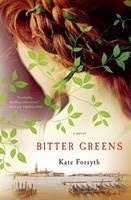 Among the 2015 selections for the Reading List, the year's best in genre fiction:
Among the 2015 selections for the Reading List, the year's best in genre fiction:
In Historical Fiction, the winner was Kate Forsyth's Bitter Greens (Thomas Dunne, 2014), a retelling of "Rapunzel" set in 17th-century France and a century earlier in Italy. Read my interview with Kate, which was based on the original Australian edition. It's great to see the novel receiving such acclaim in the US.
The Historical Fiction shortlist included Amy Belding Brown's Flight of the Sparrow (colonial New England); Nicola Griffith's Hild (Anglo-Saxon England); James Lee Burke's Wayfaring Stranger (1940s US); and Ariel Lawhon's The Wife, the Maid and the Mistress (Jazz Age Manhattan).
In Mystery, the winner was Ashley Weaver's Murder at the Brightwell (Minotaur, 2014), a Golden Age-style murder mystery set at a resort in '30s England. Read my review from last fall.
On the Mystery shortlist was Bruce Holsinger's historical thriller A Burnable Book.
Among the 26 titles on ALA's list of Notable Books, a best-of list for adult readers, was Anthony Doerr's All the Light We Cannot See (WWII France) and Richard Flanagan's The Narrow Road to the Deep North (WWII-era POWs in southeast Asia; the recent Booker Prize winner).
Congrats also to my Booklist editor, Brad Hooper, for winning the 2015 Louis Shores Award for book reviewing. Very well deserved!
Because of this blog's focus, I'll specifically list just the winners that fit with the genre of historical fiction.
 Among the 2015 selections for the Reading List, the year's best in genre fiction:
Among the 2015 selections for the Reading List, the year's best in genre fiction:In Historical Fiction, the winner was Kate Forsyth's Bitter Greens (Thomas Dunne, 2014), a retelling of "Rapunzel" set in 17th-century France and a century earlier in Italy. Read my interview with Kate, which was based on the original Australian edition. It's great to see the novel receiving such acclaim in the US.
The Historical Fiction shortlist included Amy Belding Brown's Flight of the Sparrow (colonial New England); Nicola Griffith's Hild (Anglo-Saxon England); James Lee Burke's Wayfaring Stranger (1940s US); and Ariel Lawhon's The Wife, the Maid and the Mistress (Jazz Age Manhattan).
In Mystery, the winner was Ashley Weaver's Murder at the Brightwell (Minotaur, 2014), a Golden Age-style murder mystery set at a resort in '30s England. Read my review from last fall.
On the Mystery shortlist was Bruce Holsinger's historical thriller A Burnable Book.
Among the 26 titles on ALA's list of Notable Books, a best-of list for adult readers, was Anthony Doerr's All the Light We Cannot See (WWII France) and Richard Flanagan's The Narrow Road to the Deep North (WWII-era POWs in southeast Asia; the recent Booker Prize winner).
Congrats also to my Booklist editor, Brad Hooper, for winning the 2015 Louis Shores Award for book reviewing. Very well deserved!
Published on February 01, 2015 19:55
January 28, 2015
Two new and substantial historical novel reissues: Zemindar and Csardas
Reissues can bring new life and many new readers to older, classic novels. Both Valerie Fitzgerald's Zemindar (1981) and Diane Pearson's Csardas (1975) were bestsellers in their day: massive, sweeping epics set during volatile historical eras. Both have been compared to Gone with the Wind in terms of their scope and the quality of their storytelling.
Zemindar, a novel of adventure and romance set against the backdrop of a troubled 1850s India, won the Historical Novel Prize in Memory of Georgette Heyer as an unpublished manuscript and was published by The Bodley Head shortly thereafter. When I was pulling together a list of the prize's winners in 2010, I wrote that it was a "prime candidate for reissue." Zemindar, the author's only novel, was based on her grandmother's experiences during the Sepoy Mutiny.
Csardas, named after a traditional Hungarian folk dance, tells the story of two aristocratic Hungarian sisters whose lives and fortunes change dramatically during the two world wars. Pearson, who has been writing since 1967, was president of the UK's Romantic Novelists Association for 25 years.
Both Zemindar and Csardas were reissued by the UK publisher Head of Zeus in trade paperback in 2014. Check out the gorgeous new packaging! My copy of the 1985 mass market paperback of Zemindar (which is in great condition but has teeny tiny print) stands in the background.
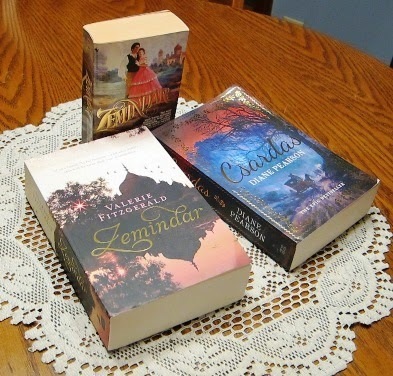
I'm looking forward to reading them both and would welcome the thoughts of anyone who's already read them. At the moment, American readers will have to order them from elsewhere, but I'll update you if there's more news on that score. I'll provide some links here because there are multiple out of print editions on bookseller sites, which can make it hard to find the new ones. Here are the UK buying options for Zemindar and Csardas on Head of Zeus's page (both are £15.00). At other sites, such as Chapters.ca and Amazon.ca, I recommend searching by ISBN to find the right ones: 9781781857519 (Csardas), or 9781781859544 (Zemindar).
All of the books in the pic above were personal purchases.
Valerie Fitzgerald, who's in her 80s and living in Ottawa, recently gave an interview with the Ottawa Citizen in celebration of the re-release, speaking about her childhood in India, her writing career, and her thoughts looking back on Zemindar 34 years later.
Since I'd written about Zemindar previously on the blog, her grandson's wife recently got in touch to tell me about the new edition, the newspaper interview, and another interview that Valerie Fitzgerald would be doing with CBC Radio. That interview aired yesterday afternoon and is available at the CBC site. It's 13 minutes long, and I found it completely fascinating to hear her discuss her life, the background to the book, some fun stories about the industry, and why she never wrote another novel. I highly recommend taking the time to listen to it.
Zemindar, a novel of adventure and romance set against the backdrop of a troubled 1850s India, won the Historical Novel Prize in Memory of Georgette Heyer as an unpublished manuscript and was published by The Bodley Head shortly thereafter. When I was pulling together a list of the prize's winners in 2010, I wrote that it was a "prime candidate for reissue." Zemindar, the author's only novel, was based on her grandmother's experiences during the Sepoy Mutiny.
Csardas, named after a traditional Hungarian folk dance, tells the story of two aristocratic Hungarian sisters whose lives and fortunes change dramatically during the two world wars. Pearson, who has been writing since 1967, was president of the UK's Romantic Novelists Association for 25 years.
Both Zemindar and Csardas were reissued by the UK publisher Head of Zeus in trade paperback in 2014. Check out the gorgeous new packaging! My copy of the 1985 mass market paperback of Zemindar (which is in great condition but has teeny tiny print) stands in the background.

I'm looking forward to reading them both and would welcome the thoughts of anyone who's already read them. At the moment, American readers will have to order them from elsewhere, but I'll update you if there's more news on that score. I'll provide some links here because there are multiple out of print editions on bookseller sites, which can make it hard to find the new ones. Here are the UK buying options for Zemindar and Csardas on Head of Zeus's page (both are £15.00). At other sites, such as Chapters.ca and Amazon.ca, I recommend searching by ISBN to find the right ones: 9781781857519 (Csardas), or 9781781859544 (Zemindar).
All of the books in the pic above were personal purchases.
Valerie Fitzgerald, who's in her 80s and living in Ottawa, recently gave an interview with the Ottawa Citizen in celebration of the re-release, speaking about her childhood in India, her writing career, and her thoughts looking back on Zemindar 34 years later.
Since I'd written about Zemindar previously on the blog, her grandson's wife recently got in touch to tell me about the new edition, the newspaper interview, and another interview that Valerie Fitzgerald would be doing with CBC Radio. That interview aired yesterday afternoon and is available at the CBC site. It's 13 minutes long, and I found it completely fascinating to hear her discuss her life, the background to the book, some fun stories about the industry, and why she never wrote another novel. I highly recommend taking the time to listen to it.
Published on January 28, 2015 11:00
January 26, 2015
An interview with Gary Inbinder, author of The Devil in Montmartre
Today I'm hosting an interview with novelist Gary Inbinder. His third novel The Devil in Montmartre, released last month, brings readers into the bustling fine art scene and dark underworld of Paris in 1889. As the city is flooded with tourists during the Universal Exposition, Inspector Achille Lefebvre, a young but highly regarded member of the Sûreté, investigates the murder of a young woman who danced the Can-Can at the Moulin Rouge.
~
The Devil in Montmartre stands well on its own, but one of your protagonists, the talented artist Marcia Brownlow – probably my favorite character – also featured in The Flower to the Painter. What made you decide to bring Marcia back for an encore appearance?
Marcia Brownlow is one of my favorite characters. After I finished The Flower to the Painter I had the idea of using her, and some of the other characters, in another novel. A fin de siècle Paris setting appealed to me, as did the idea of a murder mystery with references to Jack the Ripper.
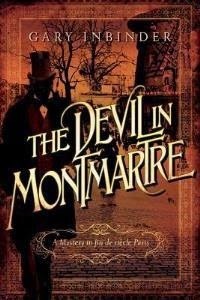 The action in the novel unfolds through many different viewpoints. How difficult of a process was it to piece together and structure the novel in this way?
The action in the novel unfolds through many different viewpoints. How difficult of a process was it to piece together and structure the novel in this way?
I had used a first person narrative in earlier novels, but I found the single perspective too limiting for this particular story. On the other hand, using multiple first person narrators seemed too complicated and potentially confusing. So, I struck a balance by using a third person narrative with multiple points of view. Once I got into it, it seemed to flow quite naturally.
I’d love to know more about your research into Montmartre in 1889, since I felt fully immersed in the setting. Based on the depth of detail, I’m guessing you know French and have spent time walking around Paris in person, though please correct me if I’m wrong!
Two admissions. First, I had two years of college French. I can still read French fairly well, but I wouldn't attempt to write or speak it. Second, my knowledge of 1889 Paris is dependent on imagination and years of reading histories and period literature, studying old photographs, paintings, drawings, maps and so forth. Of course, for months prior to writing The Devil in Montmartre, I added to my knowledge with additional research.
Your detective, Achille Lefebvre, is well-respected by his fellow detectives and known even in less reputable circles to be a trustworthy fellow. He’s not just an admirable character, though, but a likeable one. How did you come up with his personality? Will we be seeing more of him in future books?
I'm glad you liked Achille. I particularly enjoyed writing his scenes and dialogue. He combines traits of my favorite fictional detectives, including Simenon's Maigret and Sherlock Holmes. However, I tried to "humanize" him by focusing on his domestic life, especially his relationship with his wife, little daughter, and difficult mother-in-law. As for future books, there's a sequel in the works but it's a bit premature to say anything more about it.
Achille runs into some resistance when he advocates for the use of fingerprinting as an aid in solving crimes. Why was this viewed as such a radical development?
At the time, no major police force had used fingerprinting for identification purposes. However, the English anthropologist, Sir Francis Galton, published his system for fingerprint identification in the late 1880s, something I mention in the novel. In 1892, Juan Vucetich, a Croatian detective working for the Argentine police, made the first positive identification of fingerprints in a criminal case. Vucetich based his identification and classification system on Galton's writings, but it took more than a decade before police departments worldwide adopted it.
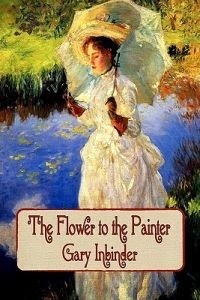 Interestingly, Samuel Clemens, aka Mark Twain, anticipated the use of a fingerprint to solve a crime in a chapter of Life on the Mississippi (1883) and he revisited the subject in The Tragedy of Puddn'head Wilson (1894).
Interestingly, Samuel Clemens, aka Mark Twain, anticipated the use of a fingerprint to solve a crime in a chapter of Life on the Mississippi (1883) and he revisited the subject in The Tragedy of Puddn'head Wilson (1894).
Your three novels convey some of the same themes – artistic creation, for one – and are set in historical times, but are a bit different genre-wise. What prompted your move into historical crime?
I'm a retired lawyer, I've had some experience working with law enforcement, and I'm partial to good historical fiction and classic crime novels. The historical mystery/crime genre offered a good vehicle in which to express my varied interests, and I just decided it was the right time to give it a try.
What originally inspired your interest in French art during the late 19th century? Do you have any favorite painters, post-Impressionist or otherwise?
I grew up with art. My late brother was a fine artist and art teacher, and my older sister majored in Art History and did some of her post graduate work at The Sorbonne. As I recall, among the first books that caught my attention when I was learning to read—or perhaps even before I could read—was a set of illustrated biographies of the painters, including Manet, Monet, Renoir, Van Gogh, Gauguin and Toulouse-Lautrec. My parents took me to the Art Institute of Chicago when I was very young. The paintings fascinated me, and the museum has a fine collection of French Impressionist and post-Impressionist paintings, including Seurat's A Sunday on La Grande Jatte.
In addition, I saw the films Lust for Life, the story of Van Gogh with Kirk Douglas, and John Huston's version of Moulin Rouge with Jose Ferrer as Toulouse-Lautrec. These have remained favorites, which I've returned to over the years. As a result, I have many sources to draw upon when visualizing scenes for my novels.
~
Gary Inbinder's The Devil in Montmartre was published by Pegasus Crime in December (hardcover, $25.95, 256pp). Visit the author's blog at http://garyinbinder.blogspot.com.
~
The Devil in Montmartre stands well on its own, but one of your protagonists, the talented artist Marcia Brownlow – probably my favorite character – also featured in The Flower to the Painter. What made you decide to bring Marcia back for an encore appearance?
Marcia Brownlow is one of my favorite characters. After I finished The Flower to the Painter I had the idea of using her, and some of the other characters, in another novel. A fin de siècle Paris setting appealed to me, as did the idea of a murder mystery with references to Jack the Ripper.
 The action in the novel unfolds through many different viewpoints. How difficult of a process was it to piece together and structure the novel in this way?
The action in the novel unfolds through many different viewpoints. How difficult of a process was it to piece together and structure the novel in this way?
I had used a first person narrative in earlier novels, but I found the single perspective too limiting for this particular story. On the other hand, using multiple first person narrators seemed too complicated and potentially confusing. So, I struck a balance by using a third person narrative with multiple points of view. Once I got into it, it seemed to flow quite naturally.
I’d love to know more about your research into Montmartre in 1889, since I felt fully immersed in the setting. Based on the depth of detail, I’m guessing you know French and have spent time walking around Paris in person, though please correct me if I’m wrong!
Two admissions. First, I had two years of college French. I can still read French fairly well, but I wouldn't attempt to write or speak it. Second, my knowledge of 1889 Paris is dependent on imagination and years of reading histories and period literature, studying old photographs, paintings, drawings, maps and so forth. Of course, for months prior to writing The Devil in Montmartre, I added to my knowledge with additional research.
Your detective, Achille Lefebvre, is well-respected by his fellow detectives and known even in less reputable circles to be a trustworthy fellow. He’s not just an admirable character, though, but a likeable one. How did you come up with his personality? Will we be seeing more of him in future books?
I'm glad you liked Achille. I particularly enjoyed writing his scenes and dialogue. He combines traits of my favorite fictional detectives, including Simenon's Maigret and Sherlock Holmes. However, I tried to "humanize" him by focusing on his domestic life, especially his relationship with his wife, little daughter, and difficult mother-in-law. As for future books, there's a sequel in the works but it's a bit premature to say anything more about it.
Achille runs into some resistance when he advocates for the use of fingerprinting as an aid in solving crimes. Why was this viewed as such a radical development?
At the time, no major police force had used fingerprinting for identification purposes. However, the English anthropologist, Sir Francis Galton, published his system for fingerprint identification in the late 1880s, something I mention in the novel. In 1892, Juan Vucetich, a Croatian detective working for the Argentine police, made the first positive identification of fingerprints in a criminal case. Vucetich based his identification and classification system on Galton's writings, but it took more than a decade before police departments worldwide adopted it.
 Interestingly, Samuel Clemens, aka Mark Twain, anticipated the use of a fingerprint to solve a crime in a chapter of Life on the Mississippi (1883) and he revisited the subject in The Tragedy of Puddn'head Wilson (1894).
Interestingly, Samuel Clemens, aka Mark Twain, anticipated the use of a fingerprint to solve a crime in a chapter of Life on the Mississippi (1883) and he revisited the subject in The Tragedy of Puddn'head Wilson (1894).
Your three novels convey some of the same themes – artistic creation, for one – and are set in historical times, but are a bit different genre-wise. What prompted your move into historical crime?
I'm a retired lawyer, I've had some experience working with law enforcement, and I'm partial to good historical fiction and classic crime novels. The historical mystery/crime genre offered a good vehicle in which to express my varied interests, and I just decided it was the right time to give it a try.
What originally inspired your interest in French art during the late 19th century? Do you have any favorite painters, post-Impressionist or otherwise?
I grew up with art. My late brother was a fine artist and art teacher, and my older sister majored in Art History and did some of her post graduate work at The Sorbonne. As I recall, among the first books that caught my attention when I was learning to read—or perhaps even before I could read—was a set of illustrated biographies of the painters, including Manet, Monet, Renoir, Van Gogh, Gauguin and Toulouse-Lautrec. My parents took me to the Art Institute of Chicago when I was very young. The paintings fascinated me, and the museum has a fine collection of French Impressionist and post-Impressionist paintings, including Seurat's A Sunday on La Grande Jatte.
In addition, I saw the films Lust for Life, the story of Van Gogh with Kirk Douglas, and John Huston's version of Moulin Rouge with Jose Ferrer as Toulouse-Lautrec. These have remained favorites, which I've returned to over the years. As a result, I have many sources to draw upon when visualizing scenes for my novels.
~
Gary Inbinder's The Devil in Montmartre was published by Pegasus Crime in December (hardcover, $25.95, 256pp). Visit the author's blog at http://garyinbinder.blogspot.com.
Published on January 26, 2015 05:00
January 24, 2015
Greer Macallister's The Magician's Lie, an involving tale of deception, female agency, and fin-de-siècle magic
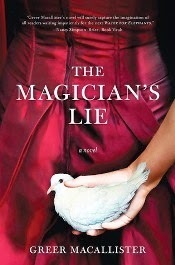 A while back, in the comments I made following my review of Timothy Schaffert’s The Swan Gondola, I confessed that I don’t usually go for novels about circuses and fairs and things of that nature. Although I loved that particular book.
A while back, in the comments I made following my review of Timothy Schaffert’s The Swan Gondola, I confessed that I don’t usually go for novels about circuses and fairs and things of that nature. Although I loved that particular book. Then I read and reviewed Rosie Thomas’ The Illusionists, about a troupe of magicians in Victorian London, and enjoyed that one, too.
Now, when presented with a 3rd recent historical novel about magic and magicians, I had no qualms about picking it up, and I’m very glad I did. The storyline grabbed me from the first paragraph, and the pacing and narrative tension remained strong through the end. Although I had correctly guessed part of the conclusion, other aspects were a surprise.
Guess it’s time for me to revisit my reading preferences – at least in terms of magicians. (I still don't like circuses.)
Set amid the alluring world of stage magic at the turn of the 20th century, Greer Macallister’s The Magician’s Lie is a novel about reality and illusion, love and betrayal, wealth and destitution, confidence and fear, truth and deception – and how quickly one can transform into the other.
The premise is thus. In Waterloo, Iowa, one evening in 1905, hours after the renowned female magician known as the Amazing Arden performs a unique variation on her controversial “Halved Man” trick, the bloodied body of a man – her husband – is found stuffed into a smashed wooden container beneath the stage. Had she killed him before the crowd as part of her act? Seizing the opportunity, Virgil Holt, a down-on-his-luck police officer from the nearby town of Janesville, catches the beautiful young woman during her planned escape and carts her into the station for questioning.
Arden claims not to know that anyone was murdered, but Holt doesn’t believe her. She insists he’ll be killing her if he doesn’t let her go. Not convinced, but willing to listen, he handcuffs her wrists to a chair to prevent her from fleeing and demands to know the truth.
And so she spins a tale about her life and career that takes her from Tennessee farm country to the vaudeville circuit and on to national fame as a brilliant and daring performer. (There’s plenty more, but I won’t be giving it away.) Is it fact or fancy or some of each? Either way, her story is so diverting that it’s easy to forget the author behind the curtain.
Edgy and exciting, The Magician’s Lie is a fast-moving historical novel that I would also recommend as a “gateway book” for introducing historical fiction to newcomers. Arden’s voice is fresh, appealing, and (seemingly) sympathetic. Without overburdening them with details, Macallister offers readers many informative new tidbits, such as the inner workings of specific magic tricks. She also presents the life of an itinerant performer in the late 19th century from an unusual viewpoint: that of a woman.
In the “conversation with the author” at the end (please save it until later if you plan to read the book!), Macallister says that since she was new to historical fiction, the writing process took about five years from initial idea to final draft. It may have required a lot of time and effort, but I think she got the difficult balance of fact and fiction pretty much right.
The Magician’s Lie is published by Sourcebooks Landmark this month (312pp, $23.99 hardcover, $9.60 on Kindle). It was on the LibraryReads list for January. I picked it up as an ARC at the publisher’s BEA booth last summer.
Published on January 24, 2015 08:32
January 21, 2015
Historical fiction at ALA Midwinter: galleys, authors, signings
I've been an American Library Association member for 20 years, but this year will be the first time I'll be attending ALA Midwinter. The conference will be held in Chicago on January 30 - February 3, so it's relatively close by. I'm looking forward to catching up with other librarians, cruising the exhibit hall, and reviewing job seekers' resumes in the Placement Center. Needless to say I'm hoping for decent weather.
Here's what I've managed to gather together as far as historical novels and novelists present at the show. Sources include Library Journal, publisher announcements, and the ALA Midwinter site.
~Galleys available~
Barbara Hoffert of Library Journal has already put together an amazing galley guide for Midwinter, so I'm not going to copy over all of the relevant HF info; just click on over to visit the LJ site. The guide is very detailed and lists settings for most of the historical novels being given away at publishers' booths, so you should be able to pick them out easily.
I have a number of galleys already thanks to publishers, Booklist, and Edelweiss, but just a few of the others I'm particularly eager about are: Shona Patel's Flame Tree Road (MIRA, June), set in late 19th-century India, which she says on her FB page is about Dadamoshai, Layla's grandfather from Teatime for the Firefly ; Jami Attenberg's Saint Mazie (Grand Central, June), set in NYC's Lower East Side during the Jazz Age; Anna Freeman's The Fair Fight (Riverhead, April), female boxers in 18th-c England (have heard great reports about it); and Susanna Kearsley's A Desperate Fortune (Sourcebooks, April), another Scottish-set romantic timeslip.
~Author appearances and signings~
Elizabeth Berg, The Dream Lover
French novelist George Sand looks back on her long, eventful, controversial life.
Monday 2/2, United for Libraries Gala Author Tea, 2-4pm, Hilton Chicago, Williford Room. Tickets required; check for prices and details.
Elizabeth Blackwell, While Beauty Slept
A retelling of "Sleeping Beauty" set in a kingdom based on medieval Europe.
Saturday 1/31, author appearance 11:00 am–12:00 pm, Pop Top Science Fiction/Fantasy Panel, McCormick Place West; signing 2:00-3:00 pm, Penguin booth 4823.
C. W. Gortner, Mademoiselle Chanel
Imagines the life of iconic 20th-century designer Coco Chanel.
Sunday 2/1, signing 9-10am, HarperCollins booth 4526; also 2/1, author appearance 10-11am, "stories of women pursuing their destiny," Pop Top Stage, McCormick Place West.
Marci Jefferson, Enchantress of Paris
Fiction about Marie Mancini in the court of the Sun King.
Friday 1/30, signing 5:30-7pm, Macmillan booth 4613.
Renee Rosen, What the Lady Wants
Subtitled "a novel of Marshall Field and the Gilded Age."
Saturday 1/31, signing 1-2pm, Penguin booth 2823; Monday 2/2, 10-11am, author appearance at Pop Top Local Author Panel, McCormick Place West.
Mary Doria Russell, Epitaph
Novel of Wyatt Earp and Doc Holliday in the Old West.
Monday 2/2, signing 11am-noon, HarperCollins booth 4526.
What galleys are you looking forward to the most, and what else am I missing? I know Chicago's not known as a hot spot in January, but even so, this seems like a short list. Please leave a comment if you know of other signings or author appearances. The list is correct as far as I'm aware, but suggestions for corrections/changes are very welcome.
Here's what I've managed to gather together as far as historical novels and novelists present at the show. Sources include Library Journal, publisher announcements, and the ALA Midwinter site.
~Galleys available~
Barbara Hoffert of Library Journal has already put together an amazing galley guide for Midwinter, so I'm not going to copy over all of the relevant HF info; just click on over to visit the LJ site. The guide is very detailed and lists settings for most of the historical novels being given away at publishers' booths, so you should be able to pick them out easily.
I have a number of galleys already thanks to publishers, Booklist, and Edelweiss, but just a few of the others I'm particularly eager about are: Shona Patel's Flame Tree Road (MIRA, June), set in late 19th-century India, which she says on her FB page is about Dadamoshai, Layla's grandfather from Teatime for the Firefly ; Jami Attenberg's Saint Mazie (Grand Central, June), set in NYC's Lower East Side during the Jazz Age; Anna Freeman's The Fair Fight (Riverhead, April), female boxers in 18th-c England (have heard great reports about it); and Susanna Kearsley's A Desperate Fortune (Sourcebooks, April), another Scottish-set romantic timeslip.
~Author appearances and signings~
Elizabeth Berg, The Dream Lover
French novelist George Sand looks back on her long, eventful, controversial life.
Monday 2/2, United for Libraries Gala Author Tea, 2-4pm, Hilton Chicago, Williford Room. Tickets required; check for prices and details.
Elizabeth Blackwell, While Beauty Slept
A retelling of "Sleeping Beauty" set in a kingdom based on medieval Europe.
Saturday 1/31, author appearance 11:00 am–12:00 pm, Pop Top Science Fiction/Fantasy Panel, McCormick Place West; signing 2:00-3:00 pm, Penguin booth 4823.
C. W. Gortner, Mademoiselle Chanel
Imagines the life of iconic 20th-century designer Coco Chanel.
Sunday 2/1, signing 9-10am, HarperCollins booth 4526; also 2/1, author appearance 10-11am, "stories of women pursuing their destiny," Pop Top Stage, McCormick Place West.
Marci Jefferson, Enchantress of Paris
Fiction about Marie Mancini in the court of the Sun King.
Friday 1/30, signing 5:30-7pm, Macmillan booth 4613.
Renee Rosen, What the Lady Wants
Subtitled "a novel of Marshall Field and the Gilded Age."
Saturday 1/31, signing 1-2pm, Penguin booth 2823; Monday 2/2, 10-11am, author appearance at Pop Top Local Author Panel, McCormick Place West.
Mary Doria Russell, Epitaph
Novel of Wyatt Earp and Doc Holliday in the Old West.
Monday 2/2, signing 11am-noon, HarperCollins booth 4526.
What galleys are you looking forward to the most, and what else am I missing? I know Chicago's not known as a hot spot in January, but even so, this seems like a short list. Please leave a comment if you know of other signings or author appearances. The list is correct as far as I'm aware, but suggestions for corrections/changes are very welcome.
Published on January 21, 2015 12:00



